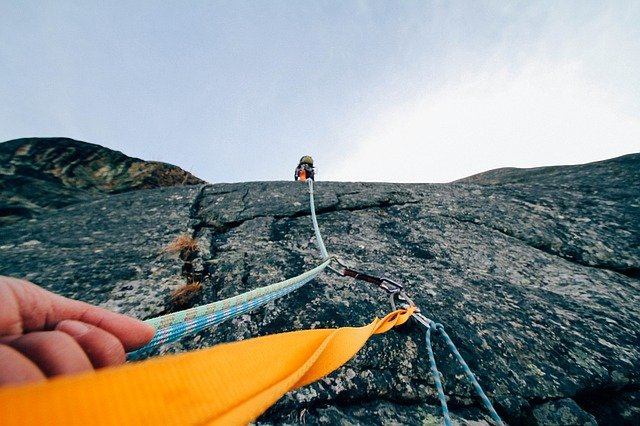Whenever I think of winters in Michigan, I think of the great times I’ve had ice climbing. From the guys to the weather to the climbing, everything falls into place perfectly.
We leave early in the morning and drive for hours. We arrive at our cabin and unpack. Then we decide whether or not to hit a climb the first day.
Most days we choose to get in at least a couple of hours of climbing. One person is climbing, another person is belaying the climber.
What Is Belaying?
Belaying is a term often used in ice climbing or rock climbing. When someone is belaying another climber, they’re the one holding another person’s life in their hands.
The climber has a rope attached to their harness. This is usually done through a figure 8 knot. The person belaying the climber has a belay device attached to their harness and the climbing rope runs through the belay device.
A belay device adds tension to the rope. As the climber climbs, the belay person pulls the rope through the belay device. Always making sure to keep as little slack as possible between the climber and the belayer.
Belaying is a crucial part of climbing. If a climber were to fall, the belayer would be able to stop the fall and prevent injury to the climber. The belayer is the climber’s lifeline, I like to say.
Belaying Leadership
I love thinking about leadership through the lens of belaying. Belaying is something I hated to do when I first began to ice climb. I felt inadequate and unfit to hold someone’s life in my hands.
What if I failed? Could I stop a person from falling? Am I fast enough to keep up with the climber?
These thoughts swirled through my mind as I told my climber to “climb on.”
His ice tool hit the ice. His crampon kicked the ice. Then he stepped up. Again and again, he ascended the face of the frozen waterfall.
I moved my hands to tighten the rope and make sure there wasn’t slack. I stepped back to add even more tension to the climbing rope.
Eventually, he reached the top. Ice tool raised in victory. He’d made it. He’d lived!
Now he had to rappel down…
We got through that together as well. He made a successful touchdown on the ground and walked away to climb another day.
I fulfilled my duty as a belayer. He did his duty as the climber.
But what can this experience belaying teach you about leadership? Let’s take a look.
Leaders help and lift up their team:
Throughout the belay experience, the onus was on me to make sure the ice climber was making progress. When he paused and thought he couldn’t make it any further, I was down there cheering him on. I was able to tell him “You can do it. You’ve got this man. Let’s see you reach the top!”
Or, if the climber began to fall, I could tighten the tension on the climbing rope. By moving more rope through the belay device or quickly stepping back, a belayer adds an extra layer of tension quickly that can stop a fall before it happens.
Both of these things equate to a leadership principle: Great leaders help and lift up their team. They’re watching and able to step in when a team member needs help.
You need to be aware of the needs of your team members. Do they need you to step in? Or do they need you to give them a little bit of slack?
Belayers know how to observe their climber and give them what they need. Great leaders know they need to do the same thing.
Leaders catch their people when they fall:
Sometimes a climber will make a bad tool placement. When they go to transition to the next part of their climb, their ice tool or crampon may release from the ice and they have the potential to fall. And climbers do fall.
The good thing is the climber has someone on belay. Someone to catch them when they fall.
After catching a falling ice climber, the belayer sometimes offers advice. They’ll coach them on what they did wrong and they’ll allow them to continue their climb.
Can you see the parallel between belaying a climber and leadership here?
Great leaders give their team members the opportunity to fail. They will even allow people to fail.
Not because they want to see people hurt. But because they know they can help coach their people to new heights after a failure.
As a leader, you can see how the failure happened, analyze the failure, and then offer constructive coaching to help them avoid the fall next time.
Leading can be uncomfortable:
Belaying was very uncomfortable to me. First, I felt the weight of the world on my shoulders. Then I had to watch over the life of the climber. Lastly, I had an uncomfortable harness that could cut circulation off. All of these things made belaying uncomfortable for me.
Leadership is much the same way. When you begin to realize how weighty leadership is, leadership becomes uncomfortable.
You feel responsible for everyone on your team.
That’s okay. Leadership isn’t for the faint of heart. Leadership is for the brave, the daring. For the ones who want to change the world.
Be okay with uncomfortable. Embrace the uncomfortableness of leading. And lead anyways.







